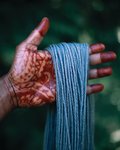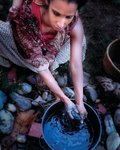Dyeing is all about life.
Textile artist and dye maven Dakshani “Daki” de Alwis actually feels it.
“It’s alive for me when I’m working with it,” she says of indigo.
This item is available in full to subscribers.
We have recently launched a new and improved website. To continue reading, you will need to either log into your subscriber account, or purchase a new subscription.
If you had an active account on our previous website, then you have an account here. Simply reset your password to regain access to your account.
If you did not have an account on our previous website, but are a current print subscriber, click here to set up your website account.
Otherwise, click here to view your options for subscribing.
* Having trouble? Call our circulation department at 360-385-2900, or email our support.
Please log in to continue |
|



Dyeing is all about life.
Textile artist and dye maven Dakshani “Daki” de Alwis actually feels it.
“It’s alive for me when I’m working with it,” she says of indigo. The striking blue pigment is maade from leaves plucked from a living indigo plant.
Before the signature hue emerges and the dye can be used to stain fabric, the leaves undergo many processes. But ultimately, at the inception of indigo is life.
De Alwis and her husband Arik Meijer are excited to offer Wool and the Forest to the world, a business focused on naturally dyed textiles and handcrafted, functional wearable art.
A love of handwork brought them together three years ago, via the social media app Instagram. Somehow, love bridged the gap between Meijer’s home in the Netherlands and the Olympic Peninsula, where de Alwis has lived permanently since 2015.
They met in person in 2019 and married last year. Both are immigrants; Meijer is still navigating a paper trail of documents.
They live outside of Port Townsend on around 10 acres of land, and their three daughters, ages 7, 6, and 18 months old, are homeschooled.
“They’re a part of everything we do,” Meijer said.
After earning multiple degrees at a university abroad, de Alwis had no intention of becoming a dyer. But retreading the backstory of her childhood in Sri Lanka to her mother’s own relationship to indigo and batik dyeing was transformational.
So, too, was discovering the global colonization of dyeing techniques and indigo.
“Thankfully for me, art and textiles found me,” she said.
De Alwis now wants to bring awareness to the world that indigo dyeing is indeed a traditional South Asian art from. And, she has formed a very personal and deep connection to her mother through indigo.
“People always used what was there,” de Alwis said, of folks on the land.
While she currently sources her indigo from a small organic farm in India, she has her own dye garden in the works. Next year, she hopes to harvest her own materials to add more colors to her spectrum.
So far, she has incorporated alder and reeds from the couple’s property into her own dyes.
De Alwis brings the word “dhane” to Wool and the Forest, a Theravada Buddhist tradition from Sri Lanka.
In an Instagram post, she explained: “At its root, dhane is essentially this; that before you claim any of the karmic fruits that await you as a result of whatever significant life event you are entering into, your first act will not be one of taking, but one of offering. Offering with no expectation of gain, undertaken with a sense of humility, given to those considered to be the guardians of the embody-energetic-ancestral landscape of the land you live on. On these Northern American lands I’ve always recognized these guardians to be its indigenous peoples, and the profound culture they embody.”
Before generating revenue for their own business, de Alwis and Meijer wanted to practice dhane. They realize their own land was stewarded by indigenous tribes, and sought a present-day cross-cultural connection to honor that heritage.
They discovered the Rainbow Fiber Co-op, a Diné cooperative centered on traditional Navajo-Churro sheep. The couple purchased 18 hanks of wool and de Alwis dyed them shades of blue, yellow and green, using indigo and other plant materials. They created an online fundraiser with all proceeds going back to the co-op.
Dyed hanks were awarded by suggested donation. Before going to their new homes, de Alwis bound them with paper hand-stamped with the family’s logo, a pine tree set against mountains, a ball-of-yarn-moon that unwinds to encircle the whole.
The dyed wool flew off of the virtual shelves, selling out within the first week, and earning more than $1,200 for the co-op.
Encouraged by the success of Wool and the Forest’s first endeavor, the couple are ready for the next step.
Soon, De Alwis will be offering indigo dyed and eco-printed wearable art such as overalls and tunics geared to makers in their online store. (She’ll also have batik-based table runners and wall hangings to accent interior spaces.) She and Meijer look forward to building a personal connection with the community, through textiles.
“It’s a way of storytelling,” she said.
Her husband took it one step further.
“It’s fiber magic,” he said.